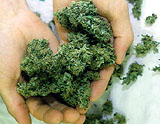"I am a crusader. I am a path-breaker. I am a trailblazer. Sometimes you pick up a few thorns when you're breaking trail ... but I'm going to be taking my medicine until the Supreme Court rules that I've been legally doing it all along." Jon Adler, medical marijuana advocate who has been arrested on drug charges |
To this day, Jim Good can’t roll a joint. It strikes him as funny, because marijuana cost him his land and the house he spent six years building. Good never considered himself a hard-core marijuana dealer. He sold lower-quality “shake,” the leaves of the marijuana plant that surround the more potent and profitable buds. But in 1985, police raided the old sugar plantation house that Good had rebuilt in the Puna District’s Orchidland Estates and found almost 80 pounds of shake, conservatively worth $8,000. Hawaii’s war on marijuana was nearing its high point, and Good became one of its casualties. His experience is a reminder of marijuana’s glory days on the Big Island and the punishment that sometimes came with it. As one grower said, “Pakalolo’s been a wonderful thing, and it’s caused a lot of pain.” Good was unprepared for the pervasiveness of the marijuana industry when he answered a cousin’s invitation to move to Puna in 1976. “The availability was extraordinary,” he said. “Marijuana was as common as coffee and doughnuts on a breakfast table. You’d go to any party and see bags of pot sitting out. People would have parties and compete to see whose pakalolo was the best.” Good, then 32, made cabinets and worked in construction. But for an investment as little as $50, he could buy a pound of Puna-grown shake, mail it to the Mainland and make as much as $2,400. “The joke was that the post office in Pahoa (southern Puna’s main business center) was so contaminated with marijuana, they couldn’t bring in search dogs because the whole place smelled,” Good said. From 1983 to 1987, Operation Green Harvest seized more plants on the Big Island — 2,479,923 — than anywhere else in the country. It also resulted in 3,031 marijuana arrests.
|
|||||||||||||||||||||||||||||||||||||||||||||||

